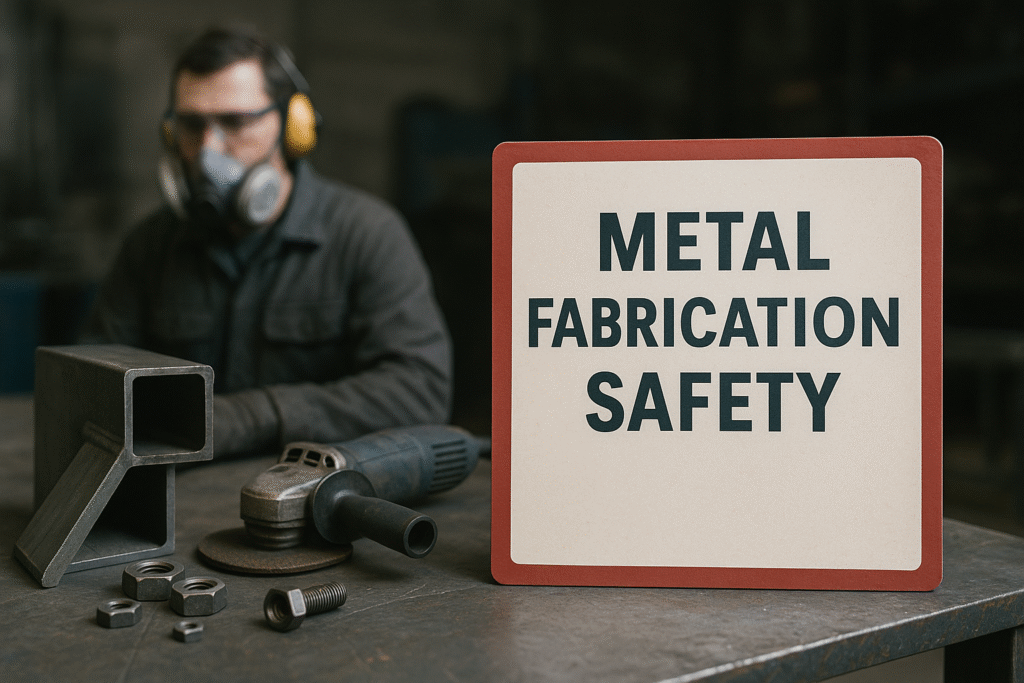Metal Fabrication Safety must be a top priority in every workshop. With the use of heavy machinery, high temperatures, sharp tools, and toxic materials, fabrication environments are inherently hazardous. Implementing strong safety protocols reduces injury risk, improves productivity, and ensures regulatory compliance.

This article outlines the most effective safety strategies for metal fabrication workplaces—designed to protect your team and maintain operational excellence.
- ✅ Personal Protective Equipment (PPE) Is Non-Negotiable
- 🧰 Machine Guarding Prevents Severe Injuries
- 🔥 Fire Safety and Hot Work Controls
- 🛠️ Material Handling and Ergonomics
- 📋 Safety Signage and Hazard Communication
- 🛑 Ventilation and Air Quality
- 📚 Training and Safety Awareness
- 🚨 Emergency Response Planning
- 🧼 Housekeeping: The Unsung Hero of Safety
- 📊 Regular Safety Audits and Continuous Improvement
- Final Thoughts on Metal Fabrication Safety
✅ Personal Protective Equipment (PPE) Is Non-Negotiable
Every worker in a metal fabrication shop must wear task-appropriate PPE. This includes:
- Safety glasses or face shields for eye and face protection from sparks and metal fragments.
- Cut-resistant gloves when handling sharp materials.
- Steel-toe boots to guard against falling objects.
- Welding helmets and fire-resistant clothing for welders.
PPE policies should be enforced through regular training and visual reminders. For example, internal shop procedures at OHSE.ca recommend weekly PPE inspections and monthly safety audits.
🧰 Machine Guarding Prevents Severe Injuries
Metal shears, grinders, punch presses, and welding equipment all pose significant risks. Machine guarding is a crucial control strategy:
- Install fixed guards on all moving parts.
- Use two-hand tripping devices or presence-sensing devices for hazardous machinery.
- Lockout/Tagout (LOTO) procedures must be followed during maintenance.
According to OSHA’s machine guarding standards, unguarded equipment is one of the top cited violations in fabrication environments.
🔥 Fire Safety and Hot Work Controls
Hot work (welding, cutting, grinding) generates heat, sparks, and molten metal that can easily ignite flammable materials.
Fire prevention best practices include:
- Maintain clean and clutter-free workspaces.
- Store flammable materials (like solvents and oils) away from hot work zones.
- Keep fire extinguishers rated for Class D (metal fires) within reach.
- Train all workers in fire response procedures.
Welders should always follow the Canadian Centre for Occupational Health and Safety (CCOHS) guidance for hot work permits and ventilation needs.
🛠️ Material Handling and Ergonomics
Handling large or heavy metal sheets can cause musculoskeletal injuries or crushing accidents.
Safe handling practices include:
- Use lifting aids like hoists, slings, or forklifts.
- Train workers on proper lifting posture and limits.
- Store materials on stable, accessible racks to reduce awkward movements.
Good ergonomics not only prevents injuries but also improves long-term productivity and reduces downtime due to fatigue.
📋 Safety Signage and Hazard Communication
Clear labeling and signage are critical in busy fabrication shops. Hazardous materials (e.g., welding gases, cutting fluids) must be labeled in accordance with the Workplace Hazardous Materials Information System (WHMIS) in Canada or the Globally Harmonized System (GHS) internationally.
Post signs for:
- PPE requirements at shop entrances.
- Emergency exits and eyewash stations.
- Noise hazard zones.
- First aid kit locations.
Proper signage boosts awareness and helps new workers quickly orient themselves to risks.
🛑 Ventilation and Air Quality
Processes like welding, grinding, and plasma cutting release harmful fumes and dust. Chronic exposure can lead to respiratory illnesses and metal fume fever.
To ensure good air quality:
- Install local exhaust ventilation (LEV) systems at fume-generating stations.
- Use HEPA filters in dust collection units.
- Provide workers with respiratory protection if required.
Monitoring indoor air quality helps ensure exposure remains below occupational exposure limits (OELs) as outlined by NIOSH.
📚 Training and Safety Awareness
Knowledge is the foundation of metal fabrication safety. Workers must understand equipment use, emergency protocols, and safe behavior.
Recommended training topics include:
- Safe use of CNC machines, grinders, and welding tools.
- Fire extinguisher operation.
- Lockout/Tagout procedures.
- First aid and CPR.
Host toolbox talks, safety briefings, and refresher sessions regularly. You can find downloadable safety modules at CCOHS.ca.
🚨 Emergency Response Planning
Preparation is critical. All fabrication shops should have a tailored emergency response plan that covers:
- Evacuation routes and assembly points.
- Fire and medical emergencies.
- Chemical spills and gas leaks.
Conduct drills every quarter and review incident reports to identify gaps in preparedness.
🧼 Housekeeping: The Unsung Hero of Safety
Clean floors, organized tools, and debris-free workbenches reduce tripping hazards and fire risks.
Best housekeeping practices:
- Schedule daily clean-up routines.
- Use containers for scrap metal and oily rags.
- Store tools safely when not in use.
Effective housekeeping is a form of passive risk prevention that supports all other safety measures.
📊 Regular Safety Audits and Continuous Improvement
Lastly, safety isn’t a “set and forget” concept. Perform routine safety audits to identify new hazards, enforce compliance, and evaluate the effectiveness of current protocols.
Involve supervisors and workers in the audit process and encourage feedback. Even small improvements in layout, tool organization, or signage can lead to significant safety gains over time.

Final Thoughts on Metal Fabrication Safety
Metal Fabrication Safety requires a proactive approach, continuous education, and a safety-first culture. By implementing the practices discussed—from proper PPE use to emergency planning—fabrication shops can significantly reduce workplace injuries and boost morale.
For more guidance on workplace health and safety practices, explore resources from OHSE.ca and other regulatory bodies.
Remember, metal fabrication safety isn’t just a policy—it’s a mindset.

No comments yet